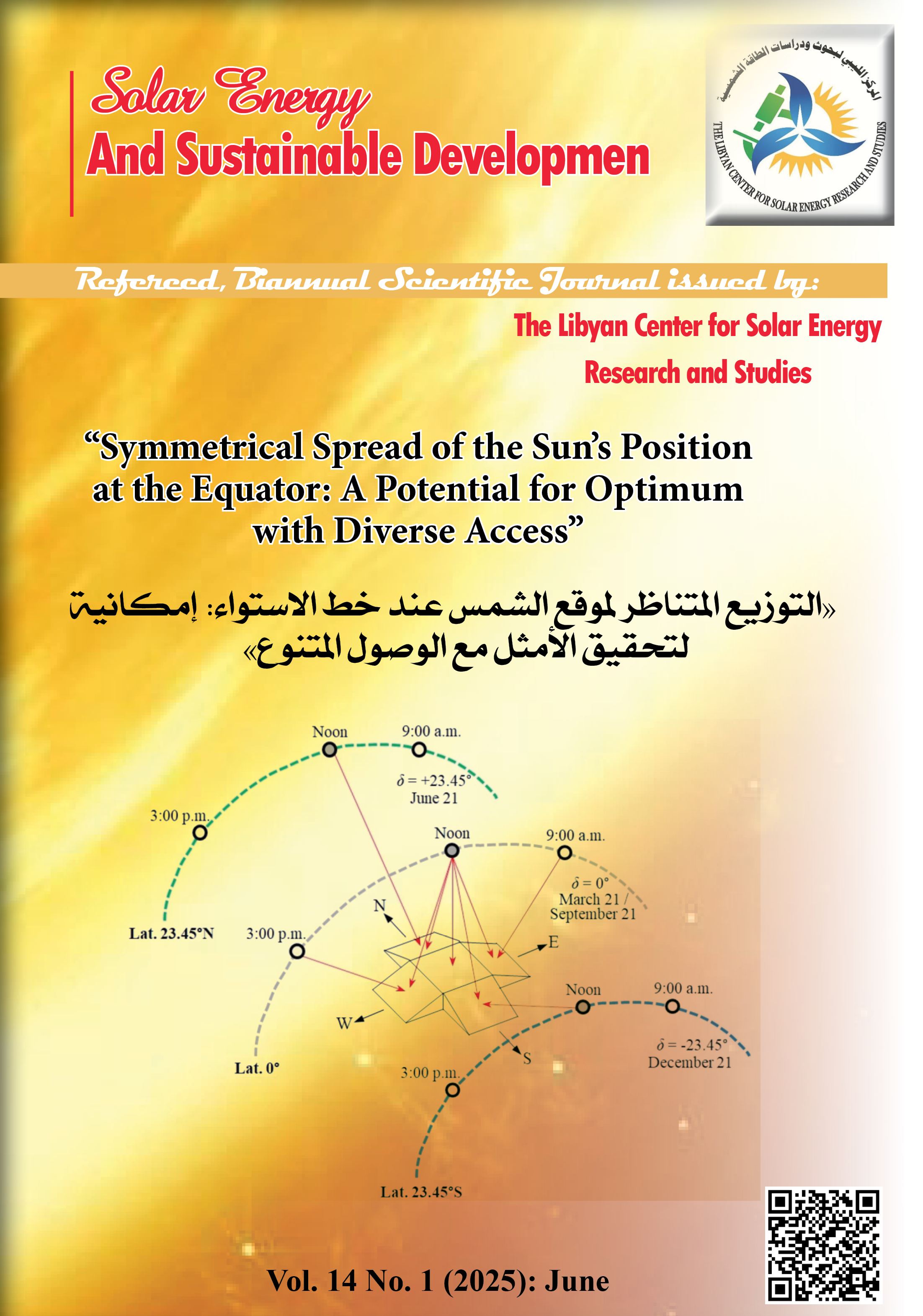Symmetrical Spread of the Sun’s Position at the Equator
A Potential for Optimum with Diverse Access
DOI:
https://doi.org/10.51646/jsesd.v14i1.227الكلمات المفتاحية:
Angular coordinate، latitude، opposite orientations، simulation calculation، solar declination angle.الملخص
تعد تصميمات المباني التي تستخدم ضوء الشمس مع تقنية تجميع الطاقة الشمسية للحصول على طاقة نظيفة أمرًا بالغ الأهمية في مواجهة تحديات تغير المناخ. تراقب هذه الدراسة موقع الشمس لمعرفة فرص وجود سطح مائل عند خط عرض معين يمكنه الوصول إلى الطاقة الشمسية لأغراض تصميم المباني. لقد أساءت معظم الدراسات السابقة فهم رؤية موقع الشمس المنتشرة في المنطقة الاستوائية كعائق أمام الوصول الأمثل لأنها تستخدم نهجًا أساسيًا للمناطق شبه الاستوائية ذات موقع الشمس المركز. تهدف هذه الدراسة إلى توضيح الانتشار المتماثل لموقع الشمس عند خط الاستواء، مما يسمح للأسطح المنحدرة بالحصول على أفضل مستوى مع اختلاف الوصول. المنهجية المستخدمة هي حساب المحاكاة والتحليل الوصفي عن طريق المقارنة. ترصد هذه الدراسة موقع الشمس من خلال الإحداثيات الزاوية للسمت والارتفاع. يتم تحديد موقع الشمس أولاً بواسطة دالة خط العرض، وبعد ذلك بواسطة دالة الوقت. تمر الشمس مرتين عند خط الاستواء في اتجاه الانقلاب الصيفي الشمالي والجنوبي. ولذلك فإن المنطقة الاستوائية لها موقع متماثل نسبيا ينتشر على أربعة اتجاهات أساسية رئيسية. تُظهر المنطقة الاستوائية إمكانية تعرض سطحين منخفضي الميل يواجهان اتجاهات متعاكسة في وقت واحد.
التنزيلات
المقاييس
المراجع
IPCC, “9-Buildings,” in Climate Change 2022: Mitigation of climate change. Cambridge: Cambridge University Press, 2022, pp. 953–1048, doi: 10.1017/9781009157926.011. DOI: https://doi.org/10.1017/9781009157926.011
N. P. Hariram, K. B. Mekha, V. Suganthan, and K. Sudhakar, “Sustainalism: An integrated socio-economic-environmental model to address sustainable development and sustainability,” Sustain., vol. 15, no. 13, p. 10682, 2023, doi: 10.3390/su151310682. DOI: https://doi.org/10.3390/su151310682
M. Soroush and Y. Hajimolana, “Sunlight harvesting,” Comput. Chem. Eng., vol. 170, p. 108103, 2023, doi: 10.1016/j.compchemeng.2022.108103. DOI: https://doi.org/10.1016/j.compchemeng.2022.108103
T. Guney, “Solar energy, governance and CO2 emissions,” Renew. Energy, vol. 184, pp. 791–798, 2022, doi: 10.1016/j.renene.2021.11.124. DOI: https://doi.org/10.1016/j.renene.2021.11.124
J. A. Duffie, W. A. Beckman, and N. Blair, Solar engineering of thermal processes, photovoltaics and wind. New Jersey: John Wiley & Sons, 2020, doi: 10.1002/9781119540328. DOI: https://doi.org/10.1002/9781119540328
G. Y. Kim, D. S. Han, and Z. Lee, “Solar panel tilt angle optimization using machine learning model: A case study of Daegu city, South Korea,” Energies, vol. 13, p. 529, 2020, doi: 10.3390/en13030529. DOI: https://doi.org/10.3390/en13030529
S. Sevik, A. Kocer, H. Ince, and F. E. Tombus, “Determination of optimum tilt angle of the solar collector and evaluation of the position of the existing buildings in terms of solar potential,” Archit. Eng. Des. Manag., vol. 18, no. 6, pp. 812–828, 2022, doi: 10.1080/17452007.2021.1926899. DOI: https://doi.org/10.1080/17452007.2021.1926899
M. M. Cabral, S. A. Lemes, M. E. de Oliveira, P. H. A. Silva e Silva, and G. P. Viajante, “Software for calculating the optimum tilt angle of PV modules in different latitudes of the southern hemisphere and solar plant sizing,” Renew Energy Power Qual J., vol. 19, pp. 304–309, 2021, doi: 10.24084/repqj19.282. DOI: https://doi.org/10.24084/repqj19.282
M. E. Matius et al., “On the optimal tilt angle and orientation of an on-site solar photovoltaic energy generation system for sabah’s rural electrification,” Sustain., vol. 13, no. 10, p. 5730, 2021, doi: 10.3390/su13105730. DOI: https://doi.org/10.3390/su13105730
H. O. Njoku, U. G. Azubuike, E. C. Okoroigwe, and O. V. Ekechukwu, “Tilt angles for optimizing energy reception by fixed and periodically adjusted solar-irradiated surfaces in Nigeria,” Int. J. Energy Water Resour., vol. 4, no. 4, pp. 437–452, 2020, doi: 10.1007/s42108-020-00072-7. DOI: https://doi.org/10.1007/s42108-020-00072-7
A. Afandi, M. D. Birowosuto, and K. C. Sembiring, “Energy-yield assessment based on the orientations and the inclinations of the solar photovoltaic rooftop mounted in Jakarta, Indonesia,” Int. J. Adv. Sci. Eng. Inf. Technol., vol. 12, no. 2, pp. 470–476, 2022, doi: 10.18517/ijaseit.12.2.14812. DOI: https://doi.org/10.18517/ijaseit.12.2.14812
I. B. K. Sugirianta, I. G. A. M. Sunaya, and I. G. N. A. D Saputra, “Optimization of tilt angle on-grid 300Wp PV plant model at Bukit Jimbaran Bali,” J. Phys. Conf. Ser., vol. 1450, p. 012135, 2020, doi: 10.1088/1742-6596/1450/1/012135. DOI: https://doi.org/10.1088/1742-6596/1450/1/012135
X. Serrano-Guerrero, D. Alvarez-Lozano, and S. F. L. Romero, “Influence of local climate on the tilt and orientation angles in fixed flat surfaces to maximize the capture of solar irradiation: A case study in Cuenca-Ecuador,” in IEEE International Autumn Meeting on Power, Electronics and Computing, Ixtapa, Mexico, 13–15 November 2019, pp. 91–96, doi: 10.1109/ROPEC48299.2019.9057102. DOI: https://doi.org/10.1109/ROPEC48299.2019.9057102
Y. S. Khoo et al., “Optimal orientation and tilt angle for maximizing in-plane solar irradiation for PV applications in Singapore,” IEEE J. Photovoltaics, vol. 4, no. 2, pp. 647–653, 2014, doi: 10.1109/JPHOTOV.2013.2292743. DOI: https://doi.org/10.1109/JPHOTOV.2013.2292743
S. Bari, “Optimum orientation of domestic solar water heaters for the low latitude countries,” Energy Convers. Manag., vol. 42, no. 10, pp. 1205–1214, 2001, doi: 10.1016/S0196-8904(00)00135-7. DOI: https://doi.org/10.1016/S0196-8904(00)00135-7
K. Y. Lau, C. W. Tan, and A. H. M. Yatim, “Effects of ambient temperatures, tilt angles, and orientations on hybrid photovoltaic/diesel systems under equatorial climates,” Renew. Sustain. Energy Rev., vol. 81, no. 2, pp. 2625–2636, 2018, doi: 10.1016/j.rser.2017.06.068. DOI: https://doi.org/10.1016/j.rser.2017.06.068
J. Cronemberger, E. Caamano-Martin, and S. V. Sanchez, “Assessing the solar irradiation potential for solar photovoltaic applications in buildings at low latitudes - Making the case for Brazil,” Energy Build., vol. 55, pp. 264–272, 2012, doi: 10.1016/j.enbuild.2012.08.044. DOI: https://doi.org/10.1016/j.enbuild.2012.08.044
K. E. N’Tsoukpoe, “Effect of orientation and tilt angles of solar collectors on their performance: Analysis of the relevance of general recommendations in the West and Central African context,” Sci. African, vol. 15, p. e01069, 2022, doi: 10.1016/j.sciaf.2021.e01069. DOI: https://doi.org/10.1016/j.sciaf.2021.e01069
N. Mukisa and R. Zamora, “Optimal tilt angle for solar photovoltaic modules on pitched rooftops: A case of low latitude equatorial region,” Sustain. Energy Technol. Assessments, vol. 50, p. 101821, 2022, doi: 10.1016/j.seta.2021.101821. DOI: https://doi.org/10.1016/j.seta.2021.101821
UN. Population Division, World population prospects 2019: Highlights (ST/ESA/SER.A/423). New York: United Nations, 2019. Available: https://digitallibrary.un.org/record/3813698?ln=en&v=pdf.
UN. Department of Economic and Social Affairs, Global sustainable development report 2023: times of crisis, times of change science for accelerating transformations to sustainable development. New York: United Nations, 2023. Available: https://digitallibrary.un.org/record/4018896?ln=en&v=pdf.
G. Notton, “Solar radiation for energy applications,” in Encyclopedia of Sustainable Technologies. Amsterdam: Elsevier, 2017, pp. 339–356, doi: 10.1016/B978-0-12-409548-9.10130-7. DOI: https://doi.org/10.1016/B978-0-12-409548-9.10130-7
W. T. Grondzik and A. G. Kwok, Mechanical and electrical equipment for buildings. New York: John Wiley & Sons, 2014.
D. Y. Goswami, Principles of solar engineering. Boca Raton: CRC Press, 2022, doi: 10.1201/9781003244387. DOI: https://doi.org/10.1201/9781003244387
A. M. Nobre, “Short-term solar irradiance forecasting and photovoltaic systems performance in a tropical climate in Singapore”, Dr. Eng. dissertation, Universidade Federal de Santa Catarina, Florianopolis, Brazil, 2015, doi: 10.13140/RG.2.1.2195.3683.
S. V. Szokolay, Introduction to architectural science: The basis of sustainable design. New York: Routledge, 2014, doi: 10.4324/9781315852409. DOI: https://doi.org/10.4324/9781315852409
mydarksky.org, Solstices and equinoxes. [Online]. Available: https://mydarksky.org/2009/12/22/solstices-and-equinoxes/. [Accessed: Aug. 26, 2022].
J. Henry, “Tropical and equatorial climates,” in Encyclopedia of world climatology. Dordrecht: Springer, 2005, pp. 742–750, doi: 10.1007/1-4020-3266-8_212. DOI: https://doi.org/10.1007/1-4020-3266-8_212
SunEarthTools.com, SunEarthTools.com-Tools for consumers and designers of solar. [Online]. Available: https://www.sunearthtools.com. [Accessed: Apr. 22, 2022].
J. J. Michalsky, “The Astronomical Almanac's algorithm for approximate solar position (1950–2050),” Sol. Energy, vol. 40, no. 3, pp. 227–235, 1988, doi: 10.1016/0038-092X(88)90045-X. DOI: https://doi.org/10.1016/0038-092X(88)90045-X
GML-NOAA, Solar calculation details. [Online]. Available: https://gml.noaa.gov/grad/solcalc/calcdetails.html. [Accessed: Dec. 27, 2023].
J. Meeus, Astronomical Algorithms, Richmond, VA: Willmann-Bell, Inc., 1998.
F. R. Shapiro, “The position of the sun based on a simplified model,” Renew. Energy, vol. 184, pp. 176–181, 2022, doi: 10.1016/j.renene.2021.11.084. DOI: https://doi.org/10.1016/j.renene.2021.11.084
A. Jenkins, “The Sun’s position in the sky,” Eur. J. Phys., vol. 34, no. 3, p. 633, 2013, doi: 10.1088/0143-0807/34/3/633. DOI: https://doi.org/10.1088/0143-0807/34/3/633
T. P. Chang, “The Sun’s apparent position and the optimal tilt angle of a solar collector in the northern hemisphere,” Sol. Energy, vol. 83, no. 8, pp. 1274–1284, 2009, doi: 10.1016/j.solener.2009.02.009. DOI: https://doi.org/10.1016/j.solener.2009.02.009
H. S. Choi, “Architectural experiment design of solar energy harvesting: A kinetic façade system for educational facilities,” Appl. Sci., vol. 12, no. 12, p. 5853, 2022, doi: 10.3390/app12125853. DOI: https://doi.org/10.3390/app12125853
J. A. Qadourah, A. Alfalahat, and S. Alrwashdeh, “Assessment of solar photovoltaics potential installation into multi-family building’s envelope in Amman, Jordan,” Cogent Eng., vol. 9, no. 1, p. 2082059, 2022, doi: 10.1080/23311916.2022.2082059. DOI: https://doi.org/10.1080/23311916.2022.2082059
J. Balter, G. Barea, and C. Ganem, “Improvements in the energy performance of buildings in summer, through the integration of ventilated envelopes on north-facing facades and roofs. The case of Mendoza, Argentina,” Habitat Sustentable, vol. 10, no. 2, pp. 94–105, 2020, doi: 10.22320/07190700.2020.10.02.07. DOI: https://doi.org/10.22320/07190700.2020.10.02.07
S. Yang, A. Cannavale, A. D. Carlo, D. K. Prasad, A. Sproul, and F. Fiorito, “Performance assessment of BIPV/T double-skin façade for various climate zones in Australia: Effects on energy consumption,” Sol. Energy, vol. 199, pp. 377–399, 2020, doi: 10.1016/j.solener.2020.02.044. DOI: https://doi.org/10.1016/j.solener.2020.02.044

التنزيلات
منشور
كيفية الاقتباس
إصدار
القسم
الرخصة
الحقوق الفكرية (c) 2025 Solar Energy and Sustainable Development Journal

هذا العمل مرخص بموجب Creative Commons Attribution-NonCommercial 4.0 International License.













